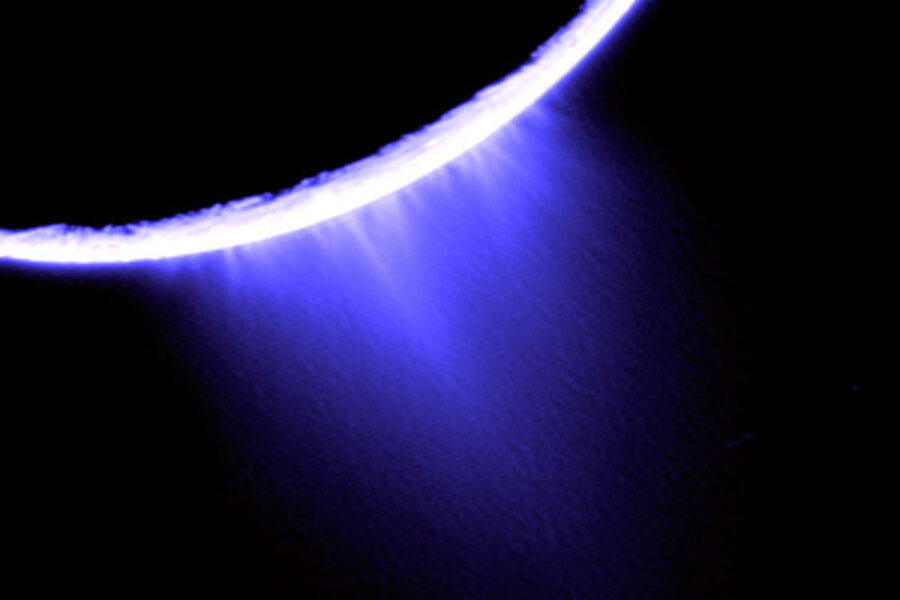What's going on inside Saturn moon? Geysers offer intriguing new clue.
Loading...
Plumes of ice crystals erupting from Saturn's moon Enceladus wax and wane in a pattern that could help reveal the inner workings of a body widely seen as a potential habitat for life beyond Earth, according to a new study.
The moon is thought to have either a global ocean under its icy crust or a sea underlying the crust in the south polar region. Theories suggest that frictional heat generated in Enceladus's interior keeps the sea from freezing. The friction is generated as Saturn's gravity tightens and relaxes its grip on the moon during each orbit.
Previous research revealed the south polar region as a hot spot whose surface is radiating up to 16 billion watts of power – roughly equal to the heat generated by 16 large nuclear power plants.
Now, it appears that tidal action is changing the amount of ice the region ejects as well – repeatedly opening and nearly closing four parallel, 80-mile-long "tiger stripe" fissures associated with the geysers feeding the plumes.
Stresses in Enceladus's crust overpower Saturn's gravity and widen the fissures when the moon reaches the most distant point in its orbit. At closest approach, Saturn's gravity overcomes the stresses and nearly shuts the fissures.
The results a reported by a team led by Cornell University planetary scientist Matthew Hedman are and set to appear in Thursday's issue of the journal Nature.
The plumes have captivated planetary scientists ever since the features were discovered in 2005. It marked the first time researchers could study a geologically active icy moon as events were happening. The material in the plumes provided a window on the chemical processes going on below the surface. The ices contain organic compounds and hydrocarbons that have piqued the interest of astrobiologists hunting for other potential habitats for life in the solar system.
Now, researchers say, they have a direct measure of the stresses at work on the crust.
In 2007, researchers published the results of modeling experiments suggesting that the moon underwent this process. That triggered a hunt to detect the effect, Dr. Hedman explains. Two other groups tried, but failed, to detect a consistent venting pattern in the different approaches they tried.
His team wasn't even looking for this effect when it started to review data gathered by Cassini's Visual Infrared Mapping Spectrometer, Hedman says. Instead, the researchers were trying to analyze the range of particle sizes in the plumes, which are known to feed one of Saturn's rings, known as the E ring.
But in poring over the data, Catherine Gosmeyer, an undergraduate student at Indiana University serving as a research assistant at the time, noted pronounced changes in the brightness of the plumes with time. Looking at the pattern, and particularly at the intensity of the changes, "I thought, 'That can't possibly be right,' " Hedman recalls.
Hedman's group began a systematic look at the VIMS data, making sure that the changes in brightness weren't just chance alignments of the plume and sunlight. In the end, the team found a consistent, repeating pattern of plume brightness that shifted with Enceladus's orbital distance from Saturn.
"We were totally blown away by how much the thing varied," Hedman says. "We thought: Maybe it would be a small effect."
Instead, the team found that plume was three times brighter at the most-distant point in Enceladus's orbit than it was at closest approach to Saturn. The moon makes one trip around the planet every 1.4 days.
A threefold change "is a pretty dramatic thing," he says.
For researchers trying to understand how Enceladus is put together and functions, the results are exciting, notes John Spencer, and planetary scientist at the Southwest Research Institute in Boulder, Colo.
"You're getting a direct handle on the stresses that are operating under the crust," he says, noting that this kind of information is unavailable for solar-system objects other than Earth.
The detection provides a rigorous test models must to pass as they try to explain how the moon is built.
"Whatever model you devise, whether it's a global ocean or a partial ocean or a more-complicated arrangement, it has to reproduce these patterns," says Dr. Spencer, who was not a member of Hedman's team, which included researchers from NASA's Jet Propulsion Laboratory, the University of Arizona, the US Geological Survey, and the SETI Institute in Mountain View, Calif.
The team's data held another intriguing clue about conditions below the ice crust, adds Geoffrey Collins, a planetary scientist at Wheaton College in Norton, Mass., who studies icy moons.
The data suggest that when Saturn's gravity clamps down on the fissures, the particles leaving the geysers emerge at higher velocities than particles do when the fissures are wider.
The opening and closing of the fissures could act in a manner similar to changing nozzles on a garden hose, he suggests.
It's a slight trend in the data, cautions Dr. Collins, who also was not among the members of Hedman's team. "But maybe there's some fairly constant background gas pressure" that's driving the geysers associated with the fissures.
The results, he says, represent "a validation that we are starting to understand – at least a little bit – how active, icy satellites behave. "Five years ago, we were really scratching our heads."







